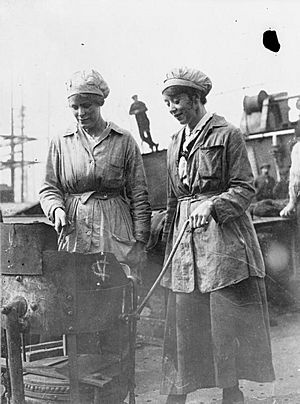The Women's Peace Crusade facts for kids
| Predecessor | Women's Peace Negotiation Crusade |
|---|---|
| Formation | 1 July 1916 |
| Founder | Helen Crawfurd, Agnes Dollan, Mary Barbour, Mrs Ferguson |
| Founded at | Glasgow |
| Type | Grassroots socialist movement |
| Purpose | To negotiate an end to World War I |
|
Key people
|
Helen Crawfurd, Agnes Dollan, Mary Barbour, Mrs Ferguson |
The Women's Peace Crusade was a movement started by ordinary people across Great Britain. It ran from 1916 to 1918. Its main goal was to achieve a "people's peace." This meant ending World War I through talks, without any country taking land from another or demanding money for damages.
The movement began in Glasgow in July 1916. It officially launched on June 10, 1917. The Crusade quickly spread across Britain. Large events took place in cities like Leeds, Bradford, and Birmingham. Many people joined the movement. However, the Women's Peace Crusade faced problems. The government and police were against them. Some members were even arrested.
Contents
How the Peace Crusade Started
The start of World War I caused disagreements among women. Before the war, many women worked for the right to vote. This was called the suffrage movement. When war broke out, some women supported the war effort. Others strongly believed in peace.
For example, Emmeline Pankhurst led a group called the Women's Social and Political Union (WSPU). She decided her group should stop working for votes. Instead, they would support the government's war plans. But many women disagreed with this idea.
In April 1915, women from across Europe met. They held a meeting in The Hague, Netherlands. This was called the International Congress of Women. Many British women wanted to go. But the British government stopped most of them. Only 24 women were allowed to attend.
This meeting led to new peace groups. One was the Women's International League for Peace and Freedom (WIL). Helen Crawfurd was a key person in Glasgow. She was a secretary for the Glasgow WIL branch. Helen Crawfurd and other working-class women felt that the WIL focused too much on middle-class issues.
So, Helen Crawfurd, Agnes Dollan, Mary Barbour, and Mrs Ferguson decided to act. They became the main organizers for peace in Glasgow. These women then started the Women's Peace Crusade.
The Women's Peace Crusade began with a large event. On July 23, 1916, about 5,000 people gathered in Glasgow. Helen Crawfurd helped organize this protest. She was a working-class woman who believed in women's rights and socialism. She had also helped with the Glasgow Rent Strike in 1915.
This protest happened after a newspaper article. The Labour Leader had criticized British women. It said they were not protesting the war enough. The first meetings of the Crusade were held in Maryhill and Springburn. They also held street meetings and marches. Members sold badges and handed out leaflets.
What the Peace Crusade Wanted
The main goal of the Women's Peace Crusade was to end World War I right away. But they had other specific aims too. Their leaflets explained what they wanted:
- All countries should choose their own governments.
- All nations should be able to grow and develop.
- Everyone should have fair access to world markets and materials.
- People should be able to travel freely.
They were against certain ideas:
- Taking over land by force.
- Trying to stop trade between countries.
- Making any country pay huge amounts of money for war damages.
The Crusade also supported limiting weapons. They wanted countries to work together. They hoped to create a shared understanding of common interests. They called this "a people's peace."
Who Joined the Peace Crusade
The Women's Peace Crusade was one of the biggest peace groups in Glasgow. It had the most support from ordinary working-class people.
Helen Crawfurd was a founder of the Crusade. She also started the Glasgow branch of the Women's International League for Peace and Freedom. Helen Crawfurd said she was not a pacifist. A pacifist believes all war is wrong. Instead, she was an "international socialist." This meant she hated war because of its cruelty and waste.
As mentioned, there were differences within the Women's International League. Middle-class and working-class members had different ideas. This led Helen Crawfurd and other working-class women to form the Women's Peace Crusade. These members included Agnes Dollan, Miss Walker, Mrs Barbour, and Mrs Ferguson.
The Women's International League held talks and discussions. But the Women's Peace Crusade took their message to the streets. They went directly into working-class neighborhoods.
Facing Challenges
The Women's Peace Crusade faced many challenges. Both the government and the media were against them. A right-wing newspaper, The Morning Post, called the movement "dangerous."
On August 11, 1917, about 1,200 women marched in Lancashire. They faced a very angry crowd of 50,000 people. These counter-protesters shouted "Traitors! Murderers!" at the women. Police had to step in to stop the women from being hurt.
See also
- Opposition to World War I
- Women in World War I


